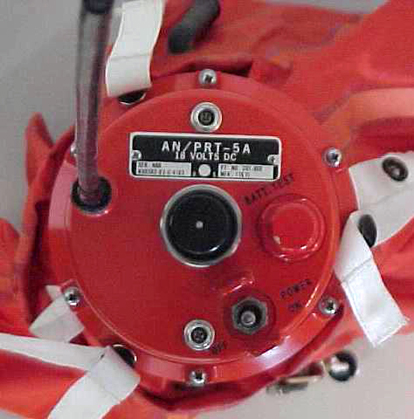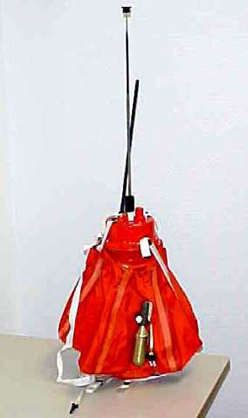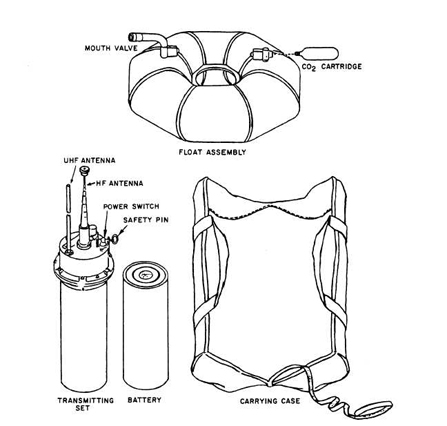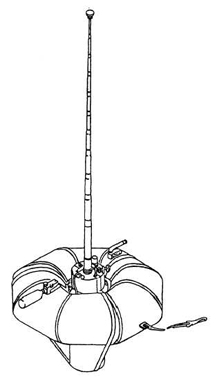AN/PRT-5 TRANSMITTING SET
Latest update 7 November 2009


Transmitting Set, Radio AN/PRT-5 is a
battery-operated, emergency beacon transmitter that, when properly
activated, transmits a tone-modulated radio frequency signal on the
emergency guard frequencies of 8.364 MHz and 243.0 MHz simultaneously.
The transmitting set includes an inflatable float assembly that keeps
the transmitting set afloat at sea, and provides a support platform on
land. The entire set is packed in a carrying case for stowing in a life
raft. The transmitting set is intended for signalling the location of
downed aircraft or airmen. Because it provides signals in both the high
frequency (HF) and ultra high frequency (UHF) portions of the spectrum,
it can be detected by search aircraft, surface vessels, and
coastal-based stations at considerable distances. The battery pack is
designed to provide 72 hours of continuous operation at 25°C (77°F) with
at least 250 milliwatts of output from each transmitter at the end of
this period. The transmitting set will continue to transmit until the
battery pack is completely discharged. Modulation of the transmitter is
by internal means only. No provision has been made for voice or code
communications, or for receiving signals from search craft. To prepare
the radio for use is a simple procedure.
1. Pull the free end of the UHF antenna through the grommet in the
float assembly to allow the antenna to stand vertically.
2. Unscrew the top section cap of the telescopic HF antenna, and pull
the antenna out to its full length. When fully raised the antenna
sections are alternate black and grey with the top section grey. The
antenna, when fully extended, is approximately 9 feet high.
3. Pull out the switch safety pin.
4. Turn the POWER toggle switch to ON.
5. Place the entire assembly in the water and tow it behind the life
raft.
6. When operating on land, be sure the transmitting set is placed on
level ground so that the antennas are vertical. Do not stand close to
the transmitting set because this can cause changes in the radiation
pattern of the transmitted signals.
7. If desired, the safety pin can be replaced to prevent the
transmitting set from being turned off accidentally.


Left: Identification of components.
Right: AN/PRT-5 with flotation collar.
Group discussions (inverse date order):
Message 389, 30 September 2000:
Erwin and All, My understanding is that the AN/PRT-5 was to be a replacement for the
AN/CRT-3 a.k.a. "Gibson Girl", a 8.364 MHz emergency beacon used since WW-II. It
was a US-cloned German NSG-2 transmitter. The Brits captured some in 1941 from the FW.200
Condors and gave them to the Americans. The "Gibbie" serves until today in some
countries, like Portugal. -- Jan Bury
Message 388, 28 September 2000:
I have both the PRT-5 and the 5A. I also have all the manuals and original sales
information on this unit. It was a Hybrid beacon. It was only used on multi-place aircraft
in the USN. Primarily on the 14 man life raft. Hybrid, because in fact it used the newer
guard frequency of 243.0 for homing, but it also incorporated the HF 8.364 mhz for long
range. The HF antenna was appx 9' long collapsing / telescoping into the unit. It used a
PRC-90 antenna and beacon system for close in homing. It used a hulking 18 volt battery
that filled the chamber. It also had a donut float so as the unit could be attached via
tether to the life raft and continue to transmit. It was a bit of a throw back considering
when it was built and subsequently fielded. Strange enough... the original patent appears
to be owned by National Cash Register. It is a very unique piece of SAR gear and I
consider it pretty hard to come by. The Navy is phasing this unit out completely and I
have to assume that the majority of these units will be destroyed. Jan Bury
Message 387, 13 September 2000:
Yes, that's quite probable. The main user was the UN Navy (note A/N designation). We
finally learnt it was a 243 MHz/8364 Mhz combo used on life rafts. Quite unique piece of
stuff. JB
Message 3xx, xx September 2000:
Jan/Erwin, judging by what Jan said about the AN/PRT-5, could it be that the unit has been
used in Dutch P-3 Orions? Regards, Hans
Message 364, 7 September 2000:
Folks, A while ago I asked whether somebody knew the use of an AN/PRT-5A bouy. I gave a
description without photos. No I 've got the photos. Does anybody know the use, where it
is stored in the plane, is it dropped later or what? Regards, Erwin Meier
Message 358, 25 August 2000:
It's a beacon transmitter. Other names URT-21 & URT-33. -- Jan Bury
Message 352, 22 August 2000:
Erwin, I checked in my files that the PRT-5A transmitter is not in the US Army/Navy
nomenclature listing. That's strange enough. Can you provide any information how it looks
like, maybe there is a manufacturer's plate there? The previous model, the PRT-4A was an
US Army Vietnam vintage transmitter, but it was used for military FM communications.
Perhaps your PRT-5A was of a foreign make. The Japanese also made such transmitters since
1960s, but they were marked JURC-A10 (Army version) or PRT-2 and RRT-4 (Navy) and were
housed in an orange cabinet. The already known Emergency Locator Transmitters, like the
AN/URT-21 and AN/URT-33 transmitted an SOS in Morse code or swept frequency beacon's
signal with a power of ca. 0.5 Watt on an international military distress frequency of 243
MHz, which is guarded by SAR. They were used so that the SAR teams could home on their
signal and find the pilot. These transmitters could be activated upon ejection. Their
current replacement in the US Navy is an AN/URT-140, which supports satellite distress
broadcasting, too. Currently, the ELT's are used in non combat environment, as the other
side can also find them. FYI: An ELT is not a toy and should never be turned on, unless
during a distress situation. The guard frequencies of 121.5, 243 and 406.025 MHz are
monitored by virtually everyone anywhere, and severe penalties for unsolicited use can be
imposed in many countries. -- Jan Bury
Message 347, 22 August 2000:
Dear Chris, Unfortunately I do not have a photo ready of the buoy. it is a bright orange
cylinder. 1 ft high 6 inches in diameter. It has a "umbrella" kind of thing
attached to it around the top, that is inflatable by means of an ox bottle. On top is a
flexible antenna of about 1 ft. When you open a little black cylinder on the top (1 inch
high) a 15 ft antenna comes out. A line with a hook is attached to it so the pilot can
attach it to its vest or float. Cheers Erwin
Message 345, 21 August 2000:
Hi Erwin, Do you have an image of the AN/PRT-5A buoy that you could post? I personally am
not familiar with the item by its designation, but I think the military PRT (Pilot
Recovery Transponder?) equipment is similar in function to what civilian aviators now call
an EPIRB (Emergency Position-Indicating Recovery Beacon), except that the EPIRB is an
automatic distress signal transmitting system, and the PRT is also a two-way communication
device (no assurances that this is absolutely correct--just a guess). I THINK (but can't
swear to it) that this device was actuated on ejection and that it was either in the
aircraft survival kit or on the pilot (in his vest). This is all just an educated guess on
my part, as I am not intimately familiar with aircrew survival equipment items, and admit
to no exceptional knowledge of this area of flight gear. Cheers, Chris
Message 340, 21 August 2000 :
Question: does anybody know what the AN/PRT-5A bouy is used for? Was it stored in the
aircraft or ejection seat? Is it to locate the pilot after ejection? Who knows the use of
this bright orange "thing". Regards, Erwin Meier